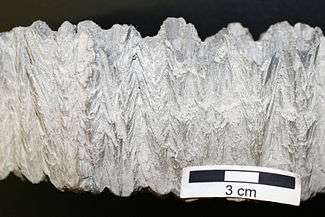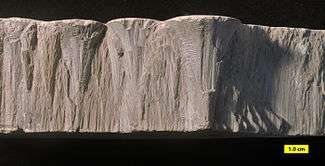Cone-in-cone structures
Cone-in-cone structures are secondary sedimentary structures that form in association with deeper burial and diagenesis. They consist of concentric inter-bedded cones of calcite or more rarely gypsum, siderite or pyrite.[1][2][3][4] Although several mechanisms may be responsible for the formation of cone-in-cone structures, displacive crystal mechanism is preferred. It accounts for the most uniform and consistent explanation of growth and why cone-in-cone can occur with such variable composition.


Description
Cone-in-cone structures are identifiable by their distinctive conical appearance. They are composed of concentric cones nested inside each other. The actual composition of the cones is variable and dependent on the environment in which they were formed, with the majority of the cone-in-cone structures being composed of calcite with thin layers of clay between cones. There are also, more rarely, structures composed of siderite, gypsum, pyrite. There are also some instances of cone-in-cone occurring within coals. Often the cone-in-cone will be found as features of calcite layers within a shale,[5] and rarely within a dedolomite (calcitized dolomite).[6]
Formation
The formation of cone-in-cone structures has been attributed to:
- Volume increase inversion from aragonite to calcite in which expansion of conical aragonite pushed cones apart and allowed for clay to intrude
- Burial-induced pressure solution and clay layers remaining as insoluble residues
- Fracturing of crystalline mineral composites that form in over-pressured chambers, with fractures forming from a decrease in pore pressure
- Formation during early diagenesis by expansive mineral growth (force of crystal growth), in which the cones are produced by the growth of cone-shaped aggregates of fibrous calcite, the clay layers originate as the crystals displace and disturb the original clay-rich sediment.[3]
- Gillman and Metzger[7] proposed that their cone-in-cone structures were formed as a result that as fibrous aragonite grew, it displaced the still plastic clay materials. This is very similar to the displacive crystal growth mechanism proposed above in point number four. The displacive crystal growth mechanism tends to be the more popular and widely used explanation for cone-in-cone formation.
In all cases the common trend is for crystal formation to begin within partially consolidated sediment. As cone-in-cone formation happens it begins to take up more and more space within the sediment bed which begins to cause pressure. The pressure results in the cone shape, as parts of the structure are under greater or lesser pressures and grow differentially based on these varying pressures. The nature of displacement from crystal growth has led many to believe that most of the actual precipitation occurs very early during shallow burial. Some have concluded that, based upon 18O depleted values from some of the cone-in-cone material that they can form later, perhaps at hundreds of meters of burial depth.[3]
History
Cone-in-cone structures have been known since the late 1700s, and people have attempted to explain the reasons for their formations. One of the earlier explanations was actually on par with the currently accepted methods for formation as discussed above. Some of the other methods offered for their formation were given by Shaub (1937).[8] It was suggested that the formation of cone-in-cone resulted from volume shrinkage and slow dewatering of highly saturated and loosely packed materials. He suggests that partially developed conical surfaces are also possible as a result of pressure developed from overlying sediments under conditions where a unilateral release of horizontal pressure may become effective. He goes on to suggest that the current explanations of his time are inadequate to cover the structure and its formation. He even suggested that formation due to crystallization was not consistent.[8] This growth due to crystallization is a significant portion of the currently accepted mode of formation.
See also
References
- Collinson, J.D.; Thompson, D.B. (1988). Sedimentary Structures (2nd ed.). Boston: Unwin Hyman. ISBN 0-04-445171-7.
- Jackson, J.A. (1997). Glossary of Geology (4th ed.). Alexandria, VA: American Geological Institute. ISBN 0-922152-34-9.
- Fairbridge, R.W.; Rampino, M. (2003). "Diagenetic Structures". In Middleton, G.V. (ed.). Encyclopedia of Sediments and Sedimentary Rocks. Kluwer Academic Publishers. pp. 219–225. ISBN 1-4020-0872-4.
- Boggs, S. (2005). Principles of Sedimentology and Stratigraphy (4th ed.). Upper Saddle River, N.J.: Prentice Hall. ISBN 0-13-099696-3.
- Carstens, H. 1985. Early diagenetic cone-in-cone-structures in pyrite concretions. Journal of Sedimentary Petrology. Volume 55. Pg 105-108.
- Kowal-Linka M. 2010. Origin of cone-in-cone calcite veins during calcitization of dolomites and their subsequent diagenesis: A case study from the Gogolin Formation (Middle Triassic), SW Poland. Sedimentary Geology 224: 54-64.
- Gillman, R.A., Metzger, W.J.. 1967. Cone-in-cone concretions from western New York. Journal of Sedimentary Petrology. Volume 37. Pg 87-95
- Shaub, B.M. (1937) Origin of Cone-In-Cone and its Bearing on the Origin of Concretions and Septaria. American Journal of Science. Pg 331-344.